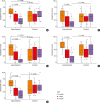1. Brozek JL, Bousquet J, Baena-Cagnani CE, Bonini S, Canonica GW, Casale TB, et al. Allergic Rhinitis and its Impact on Asthma (ARIA) guidelines: 2010 revision. J Allergy Clin Immunol. 2010; 126:466–476.
2. Asher MI, Montefort S, Björkstén B, Lai CK, Strachan DP, Weiland SK, et al. Worldwide time trends in the prevalence of symptoms of asthma, allergic rhinoconjunctivitis, and eczema in childhood: ISAAC Phases One and Three repeat multicountry cross-sectional surveys. Lancet. 2006; 368:733–743.

3. Hong SJ, Ahn KM, Lee SY, Kim KE. The prevalences of asthma and allergic diseases in Korean children. Korean J Pediatr. 2008; 51:343–350.

4. Kang SY, Song WJ, Cho SH, Chang YS. Time trends of the prevalence of allergic diseases in Korea: a systematic literature review. Asia Pac Allergy. 2018; 8:e8.

5. Yoon J, Choi YJ, Lee E, Cho HJ, Yang SI, Kim YH, et al. Allergic rhinitis in preschool children and the clinical utility of FeNO. Allergy Asthma Immunol Res. 2017; 9:314–321.

6. Sung M, Kim SW, Kim JH, Lim DH. Regional difference of causative pollen in children with allergic rhinitis. J Korean Med Sci. 2017; 32:926–932.

7. Kim DH, Park YS, Jang HJ, Kim JH, Lim DH. Prevalence and allergen of allergic rhinitis in Korean children. Am J Rhinol Allergy. 2016; 30:72–78.

8. Park HJ, Lee JH, Park KH, Ann HW, Jin MN, Choi SY, et al. A nationwide survey of inhalant allergens sensitization and levels of indoor major allergens in Korea. Allergy Asthma Immunol Res. 2014; 6:222–227.

9. Gøtzsche PC, Johansen HK. House dust mite control measures for asthma. Cochrane Database Syst Rev. 2008; CD001187.

10. Platts-Mills TA. Allergen avoidance in the treatment of asthma: problems with the meta-analyses. J Allergy Clin Immunol. 2008; 122:694–696.

11. Nurmatov U, van Schayck CP, Hurwitz B, Sheikh A. House dust mite avoidance measures for perennial allergic rhinitis: an updated Cochrane systematic review. Allergy. 2012; 67:158–165.

12. Arroyave WD, Rabito FA, Carlson JC, Friedman EE, Stinebaugh SJ. Impermeable dust mite covers in the primary and tertiary prevention of allergic disease: a meta-analysis. Ann Allergy Asthma Immunol. 2014; 112:237–248.

13. Wu FF, Wu MW, Pierse N, Crane J, Siebers R. Daily vacuuming of mattresses significantly reduces house dust mite allergens, bacterial endotoxin, and fungal β-glucan. J Asthma. 2012; 49:139–143.

14. Bousquet J, Khaltaev N, Cruz AA, Denburg J, Fokkens WJ, Togias A, et al. Allergic Rhinitis and its Impact on Asthma (ARIA) 2008. Allergy. 2008; 63:Suppl 86. 8–160.
16. Urbaniak GC, Plous S. Research Randomizer (Version 4.0) [Internet]. Lancaster (PA): Research Randomizer;cited 2013 Jun 22. Available from:
http://www.randomizer.org/.
17. Wu FF, Siebers R, Chang CF, Hsieh SW, Wu MW, Chen CY, et al. Indoor allergens and microbial bio-contaminants in homes of asthmatic children in central Taiwan. J Asthma. 2009; 46:745–749.

18. Koh GC, Shek LP, Kee J, Tai BC, Wee A, Ng V, et al. An association between floor vacuuming and dust-mite and serum eosinophil cationic protein in young asthmatics. Indoor Air. 2009; 19:468–473.

19. Vicendese D, Dharmage SC, Tang ML, Olenko A, Allen KJ, Abramson MJ, et al. Bedroom air quality and vacuuming frequency are associated with repeat child asthma hospital admissions. J Asthma. 2015; 52:727–731.

20. Wang Y, Xiong L, Yin X, Wang J, Zhang Q, Yu Z, et al. House dust mite allergen levels in households and correlation with allergic rhinitis symptoms. Am J Rhinol Allergy. 2014; 28:193–196.

21. Sercombe JK, Liu-Brennan D, Causer SM, Tovey ER. The vertical distribution of house dust mite allergen in carpet and the effect of dry vacuum cleaning. Int J Hyg Environ Health. 2007; 210:43–50.

22. Baek JH, Cho E, Kim MA, Lee SW, Kang YS, Sheen YH, et al. Response to nonallergenic irritants in children with allergic and nonallergic rhinitis. Allergy Asthma Immunol Res. 2016; 8:346–352.







 PDF
PDF ePub
ePub Citation
Citation Print
Print





 XML Download
XML Download